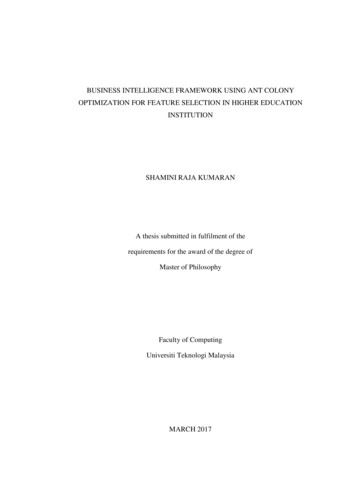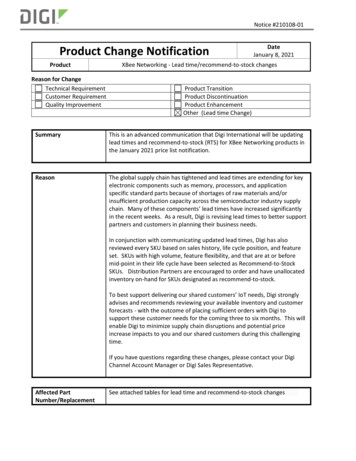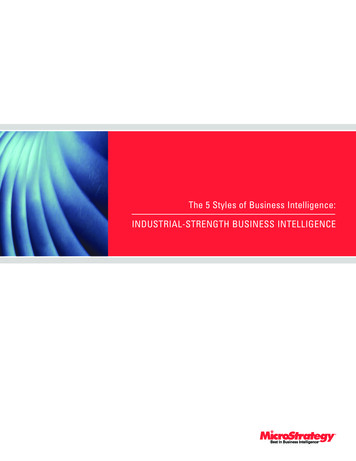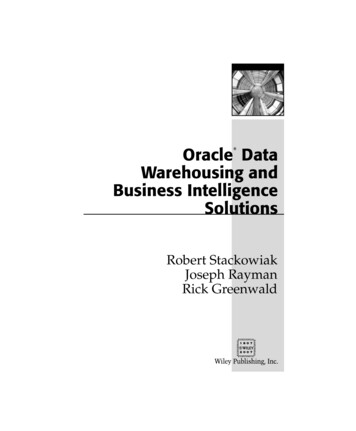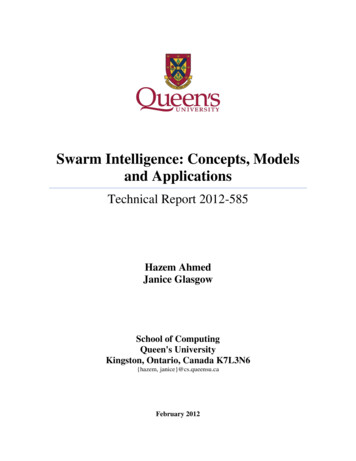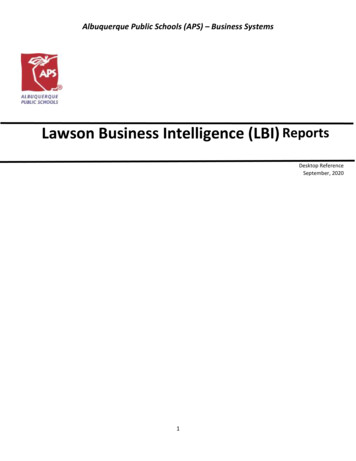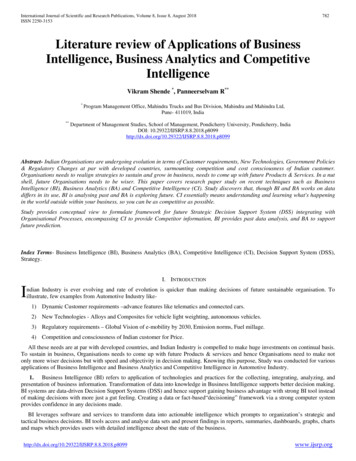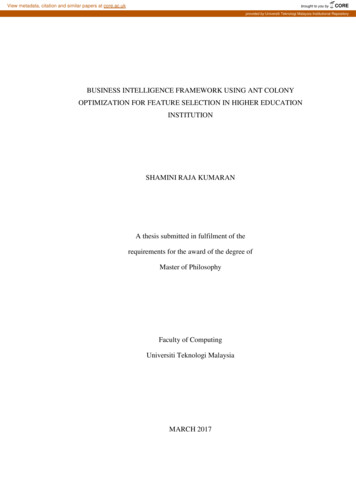
Transcription
View metadata, citation and similar papers at core.ac.ukbrought to you byCOREprovided by Universiti Teknologi Malaysia Institutional RepositoryBUSINESS INTELLIGENCE FRAMEWORK USING ANT COLONYOPTIMIZATION FOR FEATURE SELECTION IN HIGHER EDUCATIONINSTITUTIONSHAMINI RAJA KUMARANA thesis submitted in fulfilment of therequirements for the award of the degree ofMaster of PhilosophyFaculty of ComputingUniversiti Teknologi MalaysiaMARCH 2017
ivACKNOWLEDGEMENTForemost, I would like to express my sincere gratitude to my supervisor, AssocProf Dr Mohd Shahizan bin Othman for spending his time instructing me how to writea paper, how to search for literature review and how to collect data. I am also gratefulto Mrs Lizawati Mi Yusuf for spending time to read this thesis and providing usefulsuggestions about this thesis.Special thanks are given to School of Graduate Studies (SPS) and staff ofDepartment of Information Technology (IT) and Research and ScholarshipDepartment, SPS. In addition, I have to acknowledge Puan Anisah Jamilah and expertsfor their assistance in many aspects. I am also grateful to Ministry of Higher Educationfor providing me scholarship and Research University Grant (RUG), UniversitiTeknologi Malaysia (UTM) under the Vote No. 02G87 for providing the funds for thisproject.Last but not least the importance, I owe more than gratitude to my familymembers which include my parents and I would like to dedicate this especially to them.Nevertheless, thanks to my beloved ones as well for giving me support andencouragement throughout the research period. Without their boost and support, thisaccomplishment would have been impossible for me. Thank you for everyone.
vABSTRACTRecently, business intelligence (BI) has become an important tool foreffective decision-making. BI is a mathematical framework to gain information andknowledge through the process of extracting, transforming, managing, and analyzingdata. The demand for accurate knowledge in higher education sector needs a correcttechnique to extract the exact information for decision-making. However, current BIframeworks and systems lack the ability to transform data into information, and thesecaused users not to able to fully utilize the BI outcome. This research developed a BIframework for the higher education that is able to explore, analyse and visualize therelevant data into information for use by the top management. This frameworkidentifies the best set of attributes and evaluates the performance of the model withthe help of 27 input features. In this case study, the framework used Ant ColonyOptimization (ACO) technique mainly to identify the best set of attributes, and theperformance was validated using Support Vector Machine (SVM). The frameworkconsists of four layers which are data source, data integration, analytic, and access.Each layer contributes to decision making in terms of processing data, selection ofsignificant features and data visualization. In this study, 46,658 input data wereprocessed for identification of Graduate on Time (GOT) decision in the context ofhigher education referred as Masters and Doctor of Philosophy (PhD) postgraduateswho completed their study within a specified period. The performance evaluation ofthe data achieved accuracies of 86.44% for PhD and 96.2% for Master’s. Based onthe findings, the results showed that the BI dashboard as an output from theframework is capable of providing a good decision-making tool for educationmanagement.
viABSTRAKDewasa ini, kecerdasan perniagaan (BI) telah menjadi alat yang pentinguntuk membuat keputusan yang berkesan. BI ialah rangka kerja matematik spengekstrakan,transformasi, pengurusan, dan penganalisisan data. Permintaan terhadap pengetahuanyang sebenar dalam sektor pendidikan tinggi memerlukan teknik yang betul bagimengekstrak maklumat yang tepat untuk membuat keputusan. Walau bagaimanapun,rangka kerja dan sistem BI semasa kurang kemampuan untuk mentransformasikandata kepada maklumat, dan ini menyebabkan pengguna tidak dapat menggunakansepenuhnya dapatan BI. Kajian ini telah membangunkan rangka kerja BI ganalisis,danmenggambarkan data yang relevan kepada maklumat untuk kegunaan pengurusanatasan. Rangka kerja ini telah mengenal pasti set atribut terbaik dan menilai prestasimodel dengan bantuan 27 atribut. Dalam kajian kes ini, rangka kerja BI inimenggunakan teknik Pengoptimuman Koloni Semut (ACO) bertujuan untukmengenal pasti set atribut terbaik, dan prestasinya disahkan menggunakan MesinVektor Sokongan (SVM). Rangka kerja ini terdiri daripada empat lapisan iaitusumber data, integrasi data, analisis dan akses. Setiap lapisan menyumbang kepadaproses membuat keputusan dari segi pemprosesan data, pemilihan ciri-ciri pentingdan visualisasi data. Dalam kajian ini, 46,658 data input telah diproses untukmengenal pasti keputusan graduan dalam tempoh yang ditetapkan (GOT). Dalamkonteks pendidikan tinggi, GOT merujuk kepada pelajar Sarjana dan Doktor Falsafah(PhD) yang berjaya menamatkan pengajiannya dalam tempoh yang ditetapkan.Penilaian prestasi bagi data menunjukkan ketepatan yang dicapai ialah 86.44% untukPhD dan 96.2% bagi Sarjana. Berdasarkan dapatan ini, keputusan menunjukkanbahawa papan pemuka BI merupakan output daripada rangka kerja yang mampumenyediakan alat membuat keputusan yang baik untuk pengurusan pendidikan.
viiTABLE OF iiACKNOWLEDGEMENTivABSTRACTvABSTRAKviTABLE OF CONTENTSviiLIST OF TABLESxiLIST OF FIGURESxiiiLIST OF ABBREVIATIONSxviLIST OF SYMBOLSxviiINTRODUCTION11.1Introduction11.2Problem Background21.3Problem Statement61.4Research Objectives71.5Scope and Limitations81.6Significance of the Study81.7Thesis Structure91.8Summary11LITERATURE REVIEW122.1Introduction122.2Higher Education Sector122.3Business Intelligence13
viii2.3.1Business Intelligence Concept142.3.2Business Intelligence Process162.3.3Benefits and Hindrances in Business Intelligence182.4Need of Business Intelligence in Higher Education202.5Business Intelligence in Higher Education212.5.122Business Intelligence Frameworks based on HigherEducation2.5.2Comparison of Business Intelligence Frameworks in25Higher Education2.5.3Layers in Business Intelligence Framework292.5.4Comparison between Research Studies302.5.5Constraints in Business Intelligence Framework Flow312.6Feature Selection for Decision Making332.7Feature Selection for Classification342.7.1Optimization Techniques for Feature Selection342.7.2Metaheuristic Algorithm based Feature Selection in36Business Intelligence2.7.33Ant Colony Optimization392.8Commercial Business Intelligence Products422.9Summary42RESEARCH METHODOLOGY433.1Introduction433.2Research Framework433.3Research Concept443.4Planning and Preparation463.5Development of Business Intelligence Framework483.5.1Data Source Layer493.5.2Data Integration Layer513.5.3Analytic Layer583.5.4Access Layer653.6Validation693.7Verification74
ix43.8Hardware and Software Requirements763.9Summary76ANALYSIS AND RESULT OF ANT t Gathering774.3Analysis and Results from the Layers of Business Intelligence78Framework4.3.1 Data Source and Data Integration Layer794.3.2 Analytic Layer824.3.2.1 Ant Colony Optimization based Feature84Selection on PhD Dataset4.3.2.2 Ant Colony Optimization based Feature85Selection on Masters Dataset4.3.3 Analysis of Significant Features in Analytic Layer874.3.3.1 Analysis of Significant Features for PhD Data874.3.3.2 Analysis of Significant Features for Masters88Data4.3.3.3 Summary Analysis of Graduate on Time89Classification4.3.4 Comparative Analysis between Ant Colony90Optimization based Feature Selection Without AntColony Optimization based Feature Selection54.3.5 Access Layer924.4Validation and Verification974.5Summary98CONCLUSION995.1Research Summary995.2Research Contributions1005.3Research Limitations1015.4Future Work Recommendations102
x5.5Summary102REFERENCES103Appendices A – E111- 146
xiLIST OF TABLESTABLE NO.2.1TITLEPAGEBI framework components in higher education based on23researchers2.2Existing BI frameworks in education sector242.3Comparison between researches312.4Application of meta-heuristic algorithm in BI372.5Comparison on different meta-heuristic techniques for38feature selection2.6Commercial BI products423.1Requirement gathering process463.2University measurement of graduate on time473.3Descriptions of tables for ETL process523.4Features descriptions of Ph.D. and Masters datasets563.5Description of features573.6Parameter settings of ACO633.7Accuracy breakdown of SVM and other classifiers in71education sector3.8Section B of survey form questionnaires754.1Analysis from interview784.2Database cleaning79
xii4.3Retrieved PhD and Masters data794.4Total data stored in data warehouse by mode804.5Graduate data extracted from data marts824.6Accuracy comparison among SVM functions834.7SVM classification accuracy with all features for PhD83dataset4.8SVM classification accuracy with all features for83Masters dataset4.9ACO based feature selection searching process on PhD85dataset4.10ACO based feature selection searching process on86Masters dataset4.11Significant features and accuracy based on PhD dataset884.12ACO based feature selection and SVM accuracy result884.13Summary analysis of GOT classification894.14Percentage of reduction for PhD and Masters datasets904.15Performance measurement results914.16Interview session information974.17Experts profile and feedback98
xiiiLIST OF FIGURESFIGURE NO.1.1TITLEPAGEProblematic area in decision making in higher education4department1.2Bottleneck in the transition of knowledge to decisions52.1Priority of data and analysis in higher education13institution2.2Evolution of data142.3Concept of business intelligence152.4Business intelligence process model172.5Transition process172.6Tpyical flow of business intelligence architectire182.7Dependicies between process, people, and technology202.8BI solution-South African Education252.9BI design model262.10BI in educational landscape272.11BI conceptual framework282.12Five layered business intelligence architecture292.13Constraints in business intelligence flow322.14Optimization techniques embedding inflow of business33intelligence
xiv2.15Taxonomy of oprimization problems352.16Ant colony optimization movement392.17Ant colony optimization algorithm403.1Overview of research framework443.2Research study based on problem scenario453.3Business intelligence framework483.4Data source identification493.5Process in data source layer503.6Database query script for extracting data503.7Extract, transform and load process and staging area513.8Query on res stagingarea523.9Query on res dw533.10Query on INSERT533.11Data warehouse schema543.12Process of creating data mart553.13Query script for data mart display553.14Ant colony optimization based feature selection process603.15Ant colony optimization algorithm pseudo code603.16Ant colony optimization algorithm steps613.17ACO based feature selection psedu code adapted on62case study3.18Ant colony optimization class643.19Method in ant colony optimization653.20Sample manual decision making663.21Process flow in access layer67
xv3.22Developing Version 1 and 2 of dashboard683.23Flow chart of overall business intelligence dashboard693.24Example of classification via SVM classifier where C 1703.25Split datasets into 5-fold cross validation723.26Overview of classification process using SVM734.1Total retrieved data804.2Stored data in data warehouse814.3Extracted total data in 2014 by mode824.4Performance measurements of PhD data914.5Performance measurements of Masters data924.6PhD analysis with citizenship features934.7PhD analysis with scholarship and number of semester94features4.8PhD analysis with CGPA and number of publication94features4.9PhD analysis with study mode features954.10Masters analysis with citizenship features954.11Master analysis with discipline and number of semesters96features4.12Master analysis with study mode, publication, genderand number of activities features97
xviLIST OF ABBREVIATIONSBI-Business intelligenceSPS-School of Graduate StudiesUTM-Universiti Teknologi MalaysiaACO-Ant colony optimizationSVM-Support Vector MachineIT-Information technologyPSO-Particle swarm optimizationGA-Genetic algorithmRBF-Radial basis functionDT-Decision treesNV-Naïve bayesNB-Network bayesianNN-Neural networkCGPA-Cumulative grade point average
xviiLIST OF SYMBOLSC-Costγ-Gammap-Evaporation rateN-Number of antsTN-True negativeTP-True positiveFP-False positiveFN-False negative
xviiiLIST OF APPENDIXAPPENDIXTITLEPAGEARequirement gathering process111BQuestionnaire survey of business intelligence118dashboardCSVM classification of PhD and Masters122datasetsDFitness values of PhD and Masters datasets130EExperts questionnaire survey137
CHAPTER 1INTRODUCTION1.1IntroductionBusiness intelligence (BI) is a process of extracting, transforming, managing,and analyzing data by making a mathematical framework gain information andknowledge (Fitriana and Djatna, 2011). BI allows the incorporation of various ideas,methods, and components to accommodate users in any sector with actionableinformation. In order to be competitive among higher education sectors, the emphasisof BI lies in making ad hoc decisions to guarantee the quality of education that isbeing provided.Corresponding with today’s quality of education, academic institutions arebeing forced to gather, evaluate and harness their data to make effective decisions(Baepler and Murdoch, 2010). Most education sectors are facing challenges inprocessing and analyzing the data as the data are scattered at various departments(Xu et al., 2007). As a result, this research proposes a BI framework using with AntColony Optimization (ACO) based feature selection and Support Vector Machine(SVM).The current BI frameworks and systems lack in terms of transforming datainto information, and this causes users not able to fully utilize the BI outcome(Zulkefli et al., 2015). It is an undeniable factor that the demand for accurateknowledge requires a good technique to extract the exact information for accuratedecision-making. Hence, using ACO in BI is very recent among the research and it isbelieved that this algorithm is diversified to solve a wider perspective of problems
2and can be reduced to search for good paths (Krishnaraj and Vinothkumar, 2014).Feature selection is applied to the BI framework, in order to identify the best set ofattributes and evaluates the performance of the model with the help of input features.Support Vector Machine (SVM) has been chosen as the classifier to validate thealgorithm in BI framework. These methods are integrated into the BI framework, inorder, to explore, analysis and visualize the relevant data into information. Theupcoming section gives the description of the existing problems that cause theemerging of this research.1.2Problem BackgroundThe market growth toward the application of business intelligence (BI) hasseen a positive impact in organizations and provide deeper insights of data (Gartner,2016). The forecast of BI spending which is recently released showed an increase to5.2% from 2015 to 2016 hitting 16.9 billion (Gartner, 2016). According to IDGEnterprise (2016), a recent survey of Chief Information Officer (CIO), 231respondents who indicated they are the Information Technology (IT) executivesrevealed that 50% increase in usage of BI and analytics compared to last 12 months.Therefore, it can be seen that BI adoption is common in developed countries, incontrast, the reports of deployment of BI in developing countries such as in Malaysiahas been scarce (Ong et al., 2011).In Malaysia, there is a lack of evidence of deployment of BI, especially inhigher education sector. In order to globalize the higher education market inMalaysia, Malaysia higher education system must attentive in opening new marketsand utilize intelligence systems (Grapragasem et al., 2014). Malaysian highereducation system should reap full benefits from the BI to be competitive and lead toeffective decision-making. This is to ensure Malaysian higher education institutionspresent high accuracy of decision-making.Accordance to Malaysia Education Blueprint, Higher Education 2015-2025(2015), universities in Malaysia is experiencing a dramatic change over which istriggered by the disruptive emerging trend of technologies. The bodies in universities
3such as faculties, schools, libraries and student bodies are under maximised pressureto increase the level of effectiveness and productivity on decision-making. Thisresearch proposes the improvement of decision-making in the case study of GraduateOn Time (GOT). This case study entails on Graduate On Time (GOT) under thecontext of higher education refers to students who completed their study withinspecified duration as stated by one of the interviewees under this research.This case study under this research will unlock the improvement of decisionmaking around the abilities of postgraduates who completed their study within theduration allocated. This directly impacts the decision-making, by making theinformation are more easily accessible to all levels of managements. The ability tounderstand the features that contribute a postgraduate to attain the GOT status andavailability of the data based on the significant features allow the university to directthe right information to right people at a correct time.Generally, higher education institutions operate in a rapidly changingbusiness environment requires a decision-making framework as a kick-start for theinstitution. Focusing on academic institutions, a number of higher educationinstitutions are failing to be effective in terms of students’ success rate, graduate ontime rates, enrolment targets, and staff retentions (Piedade and Santos, 2010).Nevertheless, universities are obliged to play the main role to monitor andunderstand the performances and elicit the factors that react in postgraduateenrolment and tuition, finance, scholarship, staffing, and asset management (Beckettand Mccomb, 2012; Mutanga, 2015). Therefore, higher education institutions havedefects that initially affect the quality of decision-making and its academic analyticalprocesses. As stated by Prem and Karnan (2014), there are no consistent enterprisewide BI methodologies as such it proves that there is analyst using Microsoft Exceland Spreadsheets functions. This inconsistency allows the inability of users to gaindecisions from data.Based on the interviews conducted in this research, the task force team hashighlighted that “The analysis of a large amount of data consumes a lot of time,subsequently delaying the decision-making process of the department. The delay inthe decision-making leads to the delay of decision-making and forces the use of
4intuition and experience of staff.” It is common for higher education staffs to dealwith huge amounts of students’ data with numerous features detail. The problem hereis, how to handle huge amounts of students’ data using BI with numerous featuresdetail which affect the performance of management in terms of accuracy indecisions. Liu et al. (2011) have stated by performing the pre-processing processwith all dataset features are less encouraging with a total accuracy of 75.9%, while,using proposed feature selection technique, 80.2% accuracy will be improved.Nevertheless, the other problems highlighted by the scope and case study ofthis research is the decision makers use manual data visualization using MicrosoftExcel and PDF file. Figure 1.1 illustrates the problem are that emerge this researchthat causes the time of consumption in the decision-making process.Check the validityof dataStudentsAdministrativeNo validInform to person incharge in UTMAcademicValid dataCheck current dataIncompleteCompleteRefer to MicrosoftAccess, check thealternative of current dataTransfer the data intoMicrosoft WordsTransfer the data intoMicrosoft ExcelData analysisFigure 1.1OutputGraphical analysis usingMicrosoft ExcelProblematic area in decision-making in higher education department
5The problematic area leads to the data lack analytical and failed to facilitateall level of administration in the departments as stated by the BI task force during theinterview on 7th January 2016. The real scenario of manual data visualization is thestaff in-charge will extract the data from the databases and will pass it to the researchofficer in Excel format. This research officer will use extracted data and conductmanual visualization using Microsoft Excel without the knowledge of specific userrequirement and give PDF file with to the top management who requires it fordecision-making.Hence, this research addresses these shortcomings by incorporating metaheuristic algorithm and data mining for decision-making purposes so that BI systemfor higher education can be robust towards the shifting needs of the academic sector.Thus, this research proposed to develop a BI framework in order to assist thedecision makers to full use of their information, in the sense, the transformation ofdata into decisions.Current BI frameworks in the higher education sector have neglected themodeling of some important underlying processes that may affect the data. Thisresearch has discussed on eight frameworks on higher education based BIframeworks in upcoming Chapter 2. Based on the eight frameworks, it is able tosummarize that there is an existing gap between data and decisions. Nenortaite andButleris (2009) has a perspective that existing business intelligence frameworks stillhave limitations and focused on three main constraints, namely, data collection, datatransformation and visualization of knowledge. Figure 1.2 illustrates thesummarization of the research gap between information and decisions in thisresearch.Figure g bottleneckBottleneck in the transition of knowledge to decisions
6Although the importance of closing the gap linking information and decisionshas been identified and steps have been proposed, the frameworks that have beenproduced to model the process flow for decision-making for higher education sectorstill has its gaps. As a result, management is still unable to possess a complete viewof the information via dashboards for decision-making. As stated by Guster et al.(2014), toward gaining a good outcome of decision-making, the business intelligenceshall invest in the transformation of data to decisions.Thus, to extract decisions from the datasets before injected into datavisualization for decision-making in business intelligence, an optimization techniquewhich is meta-heuristic algorithm has to be incorporated for better decision-making.The important function of a BI framework is to give suitable decisions. The idea ofcarrying out optimization techniques will assist BI in achieving the single versiontruth of decisions. Hence, this depicts that proper meta-heuristic algorithm is requiredto produce accurate decisions to higher education.In this research, ACO based feature selection is incorporated into theframework in order to provide accurate decision-making. As supported by Anushaand Nallaperumal (2015), ACO as a metaheuristic algorithm creates efficient andaccurate decision-making as it assists in transforming raw data into actionableinformation. Feature selection plays a huge necessity of choosing significant andinformative features in order to improve the quality of decision-making (Pudil andSomol, 2008). BI allows descriptive modelling approach whereby by incorporatingACO based feature selection in BI framework, it allows to evaluate the performanceof the case study with the help of input attributes (Anusha and Nallaperumal, 2015).Hence, the problem background leads into next section, problem statement.1.3Problem StatementTo invest the knowledge into decisions, it fully depends on two main factorswhich are extracting the knowledge from the data and visualizing the knowledge intothe dashboard. So, business intelligence (BI) has the capability to visualize data,however, the limitation is the users who unable to gain decision from the data.
7Therefore, implementation of a meta-heuristic algorithm based feature selection inbusiness intelligence framework is a way to select the informative and potentialfeatures for decision-making.Nevertheless, the main problem that has been highlighted in problembackground is anticipated to be solved via these research questions. The mainresearch question is, “How to develop a BI framework to handle decision-makingproblem for higher education?”From the main research, the following questions are addressed:i)What are the existing BI frameworks aspects of meta-heuristic algorithmand feature selection that have been implemented in the higher educationsector?ii)How to develop a business intelligence framework for higher educationintegrating with a meta-heuristic algorithm for feature selection?1.4Research ObjectivesThe main aim of the research is, “To develop a business intelligence (BI)framework using ACO algorithm with feature selection to handle decision-making inhigher education sector”. To accomplish the aim, the research objectives arespecified as follows:i)To evaluate the existing BI frameworks to support decision-making in highereducation.ii)To develop a business intelligence framework for higher education using AntColony Optimization (ACO) based feature selection.
81.5ScopeThe scopes of research are as follows:i)The output of business intelligence in support management decision-makingat School of Graduate Studies (SPS), Universiti Teknologi Malaysia (UTM).ii)BI framework implemented on Postgraduate by Research Mode comprisingPhD and Masters students from the enrolment year 2010 till the year 2013,with the total data of 46,658.iii)Using ACO based feature selection to select significant features from theGraduate On Time (GOT) case study through the layers in BI framework.iv)Apply SVM classifier to validate the data respective to the GOT case studyBI framework.1.6Significance of the StudyThis research indeed will be significant as it endeavors to build a BIframework with the meta-heuristic algorithm, as for this research, theimplementation of ACO algorithm to be used by top management, staff and endusers to assist them in decision-making. Accordance to this research, the outcome ofthis research will be significant and benefits higher education institutions. The firstcontribution of this thesis is the BI framework using the ACO algorithm basedfeature selection. This is to identify the best set of attributes and evaluates theperformance of the model with the help of input attributes. The other significants areas follow:i)Theoreticala) Provides a clear understanding of business intelligence, data miningmethods, meta-heuristic algorithms based on feature selection focuseson higher education within the context of research-based postgraduates.b) Provides a clear description flow of BI framework and the existence ofbottleneck in transforming information to decisions.c) Provides a new BI framework using ACO based feature selectionalgorithm.
9ii)Higher education top management, staff and BI end-userProvide a clear BI framework using ACO algorithm based feature selection.This allows portraying sensible decision through selected features via theGOT case study. Users are able to monitor and elicit the factors that reactamong postgraduate students without the usage of intuition-feel.iii)ResearchersThere has been little research on business intelligence for higher education.Hence, this study contributes new knowledge for business intelligence byusing ACO algorithm based feature selection and validate using SVMclassifier in the BI framework for attribute selection before visualizing thedecisions in the dashboard. This research can be beneficial for thoseresearchers whom would like to expand the expertise in business intelligencefield for any sector not specifically higher education.1.7Thesis StructureThis thesis is organized into six chapters where Chapter 1 for introduction,Chapter 2 is the section of literature review, Chapter 3 discusses the research designand methodology of this research and Chapter 4 is the detail explanation indeveloping the business intelligence (BI) framework integrating with ACO algorithmbased feature selection for the purpose of attribute selection. While Chapter 5 is tomeasure and validate the implementation of ACO algorithm in integrating into BIframework based on the criteria of attribute selection. Chapter 6 is the conclusion,recommendation and future works under this research. The content of the chapters isbriefly illustrated as the following:i)Chapter 1This chapter introduces the problem background of this research, researchobjectives, research questions, scope and limitations, the significance of thestudy and the structure of the thesis.
10ii)Chapter 2Chapter 2 discusses the fundamental and theories of this research study whichare derived from the previous work. The terms such as business intelligence,meta-heuristic algorithm, ACO algorithm, feature selection, existing BIframeworks under the context of higher education and the case study ofprevious work are discussed in this chapter.iii)Chapter 3Chapter 3 is the chapter that is focused on the flow of research and itdiscusses the research design and methodology. Chapter 3 also devoted ingiving the detailed mapping between the research problems, phases of theresearch, chapters involved, research activities and the objectives. Thischapter also contributes toward the explanation on the development of the BIframework using ACO based feature selection for GOT case study. Thestrategic and systematic step of developing the BI framework for highereducation is one of
2.5.3 Layers in Business Intelligence Framework 29 2.5.4 Comparison between Research Studies 30 2.5.5 Constraints in Business Intelligence Framework Flow 31 . 2.8 Commercial Business Intelligence Products 42 2.9 Summary 42 3 RESEARCH METHODOLOGY 43 3.1 Introduction 43 3.2 Research Framework 43 3.3 Research Concept 44 3.4 Planning and .
